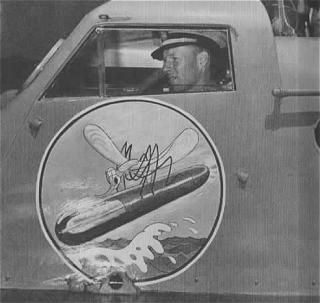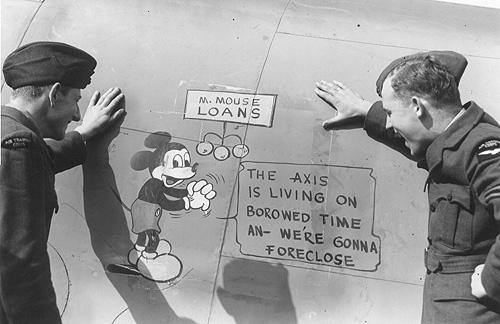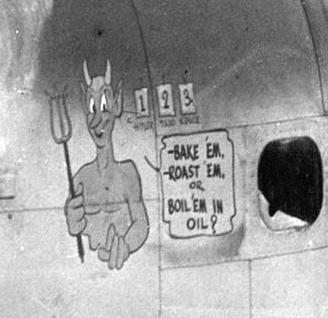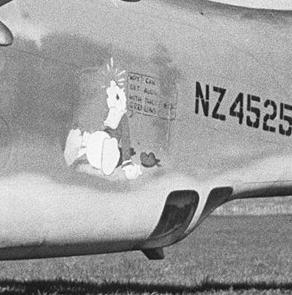 One
day in 1942, when new Navy torpedo boats were being launched,
Lieutenant E. S. Caldwell, then of the Naval Operations office in
Washington, wrote a letter to Walt Disney in Hollywood. He asked
Disney to design an emblem appropriate for this new fleet of
"mosquito boats." A few days later, back to the fleet came an
emblem. It was a little mosquito, streaking through the water with a
tar's hat on his head and a shiny torpedo held between his many
legs. The insignia was such a hit that every torpedo boat in the
fleet soon had a Disney mosquito. (In the photo at left, the
insignia adorns the cabin of a PT boat.
One
day in 1942, when new Navy torpedo boats were being launched,
Lieutenant E. S. Caldwell, then of the Naval Operations office in
Washington, wrote a letter to Walt Disney in Hollywood. He asked
Disney to design an emblem appropriate for this new fleet of
"mosquito boats." A few days later, back to the fleet came an
emblem. It was a little mosquito, streaking through the water with a
tar's hat on his head and a shiny torpedo held between his many
legs. The insignia was such a hit that every torpedo boat in the
fleet soon had a Disney mosquito. (In the photo at left, the
insignia adorns the cabin of a PT boat.
 As
soon as word got around in the Army and Navy as to what Disney had
done, the Disney office was bombarded with requests to design
insignia for tanks, minesweepers, bombers, and fighter planes.
Disney did his best to comply. When Brigadier General S. B. Buckner,
commander of the Alaska Defense Force at Fort Richardson, Alaska,
received his outfit's design — a seal balancing the letters ADF, the
general wrote Disney:
As
soon as word got around in the Army and Navy as to what Disney had
done, the Disney office was bombarded with requests to design
insignia for tanks, minesweepers, bombers, and fighter planes.
Disney did his best to comply. When Brigadier General S. B. Buckner,
commander of the Alaska Defense Force at Fort Richardson, Alaska,
received his outfit's design — a seal balancing the letters ADF, the
general wrote Disney:
Since the arrival of the insignia,
all of the seals in Bering Sea have been out on the ice pack
balancing Ds on their noses, sneering derisively at the polar bears,
expanding their chests, and cavorting merrily over being chosen to
represent our defense forces.
It was clear that Disney and
his artists had created a whole new system of heraldry, comparable
to the ancient knightly arms. With requests for insignia stilt
pouring in from the Army and Navy, the Disney studios announced that
they had already completed more than 200 designs, and were expected
to do at least 500 more. Two of their artists were working full time
on the job.

If you've ever watched a WW II movie,
you’ve probably seen an unusual and little-documented art form
called "nose art." That's the term for the cartoons, drawings, and
other markings that military crews painted on the noses of their
aircraft beginning in France in the First World War. Walt Disney
drove an ambulance in France shortly after World War I, and it's
likely that he would been exposed to early nose art. In 1939, the
famed American cartoonist was asked by the United States Navy to
design a crest. Disney came up with a cartoon showing a wasp with
boxing gloves, then went on to form a five-person team that created
1,200 aircraft insignias between 1939 and 1945.
According to the late WW II aviation
enthusiast and author Jeffrey Ethell, "the Disney industry was
pervasive in American culture and it influenced nose art in a number
of different ways. Combat crews copied Disney cartoon characters
because they were suitable subjects for humorous and patriotic
themes. Disney's influence also included studio artists, who joined
the military and then contributed their talents to the creation of
nose art. Disney Studios and the U.S. government had a history of
cooperation. At the beginning of the war in 1939, Walt Disney and
his artists designed and painted squadron and unit insignia. Disney
raised the spirit of the troops when he transformed the 'once staid
military heraldry format created during World War I' into inspired
designs. By the end of World War II, Disney's five-man staff
assigned to insignia completed over 1,200 unit insignias, never
charging a fee to the military."
The photos below show copies of
Disney characters done by members of the Royal New Zealand Air
Force, showing that Disney's influence transcended the globe in the
1940s.

Two Royal New Zealand Air Force (RNZAF) Air
Training Corps (ATC) cadets
viewing the artwork on a Lockheed Ventura fuselage, 1943 (aircraft type
and serial
is unknown). Mickey Mouse, proprietor of "M. Mouse Loans" says: "The Axis
is
Living on Borrowed Time, An' We're Gonna Foreclose."

A NZAF Lockheed Ventura (No. NZ4509) with a
Disney devil affixed.
The numbers 1-2-3 are labeled Hitler, Tojo, Il Duce. The devil's dilemma
is
whether to "bake 'em, roast 'em, or boil 'em in oil."

Another Donald Duck cartoon on NZ 4525.
This one's asking "Why Can't I Get Along With the &#$@@%! Gremlins?"
Who were the Gremlins you ask? Click
here to find out!